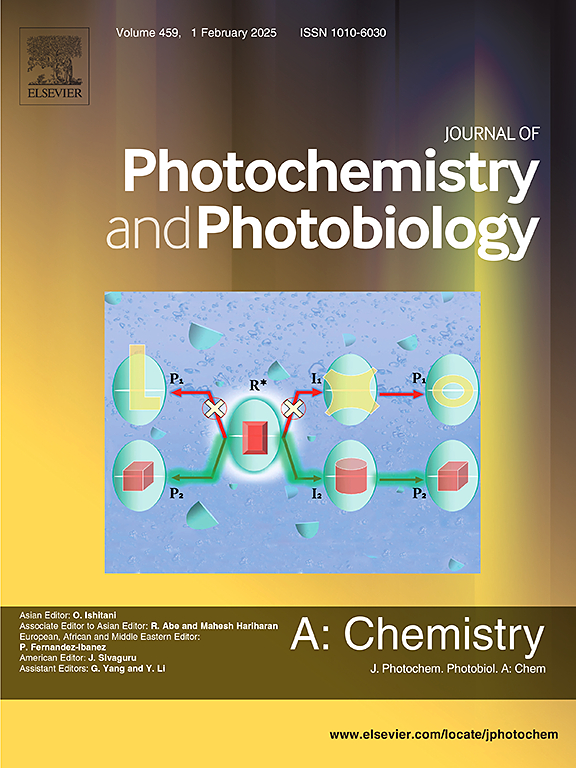Evaluations of the effects of the Nd:YAG laser on the structural, optical, spectral, and biological properties of uncoated and silver oxalate-coated mixed cadmium/cobalt oxalate
IF 4.7
3区 化学
Q2 CHEMISTRY, PHYSICAL
Journal of Photochemistry and Photobiology A-chemistry
Pub Date : 2024-09-24
DOI:10.1016/j.jphotochem.2024.116048
引用次数: 0
Abstract
Two oxalate composites were synthesized: CdC2O4/CoC2O4 (oxalate A) and Ag2C2O4/CdC2O4/CoC2O4 (oxalate B). These composites were subsequently irradiated with an Nd:YAG laser at wavelengths of 532 nm and 1064 nm. The study aimed to investigate the effects of pulsed laser irradiation on the physical properties and antibacterial activity of these oxalates. X-ray diffraction (XRD) analysis revealed that both oxalate composites were polycrystalline. Laser irradiation led to an increase in average crystal size for both materials. Scanning electron microscopy (SEM) observations confirmed this trend, with a more pronounced effect observed at the longer wavelength of 1064 nm. Oxalate A exhibited a higher optical bandgap compared to oxalate B. Laser irradiation resulted in a bandgap increase for both materials. Photoluminescence peak intensity decreased due to the laser treatment. However, the presence of silver in oxalate B significantly enhanced the luminescence intensity. When examining antibacterial activity, the incorporation of silver into the oxalate composition demonstrated remarkable efficacy in eradicating bacteria and other deleterious microorganisms. Furthermore, the results showed that, under the assumption that all other laser parameters stayed the same; a laser wavelength of 1064 nm produced more effective results in distilled water than a wavelength of 532 nm.

评估掺钕钇钕石榴石(Nd:YAG)激光对未涂层和草酸银涂层混合镉/草酸钴的结构、光学、光谱和生物特性的影响
合成了两种草酸盐复合材料:CdC2O4/CoC2O4 (草酸盐 A)和 Ag2C2O4/CdC2O4/CoC2O4 (草酸盐 B)。随后用波长为 532 纳米和 1064 纳米的 Nd:YAG 激光对这些复合材料进行照射。该研究旨在探讨脉冲激光辐照对这些草酸盐的物理性质和抗菌活性的影响。X 射线衍射(XRD)分析表明,这两种草酸盐复合材料都是多晶体。激光辐照导致两种材料的平均晶体尺寸增大。扫描电子显微镜(SEM)观察证实了这一趋势,在波长较长的 1064 纳米波段观察到的效果更为明显。与草酸盐 B 相比,草酸盐 A 的光带隙更大。激光处理导致光致发光峰强度降低。不过,草酸盐 B 中银的存在大大增强了发光强度。在检测抗菌活性时,将银掺入草酸盐成分在消灭细菌和其他有害微生物方面表现出了显著的功效。此外,研究结果表明,在所有其他激光参数保持不变的前提下,波长为 1064 纳米的激光在蒸馏水中产生的效果比波长为 532 纳米的激光更有效。
本文章由计算机程序翻译,如有差异,请以英文原文为准。
求助全文
约1分钟内获得全文
求助全文
来源期刊
CiteScore
7.90
自引率
7.00%
发文量
580
审稿时长
48 days
期刊介绍:
JPPA publishes the results of fundamental studies on all aspects of chemical phenomena induced by interactions between light and molecules/matter of all kinds.
All systems capable of being described at the molecular or integrated multimolecular level are appropriate for the journal. This includes all molecular chemical species as well as biomolecular, supramolecular, polymer and other macromolecular systems, as well as solid state photochemistry. In addition, the journal publishes studies of semiconductor and other photoactive organic and inorganic materials, photocatalysis (organic, inorganic, supramolecular and superconductor).
The scope includes condensed and gas phase photochemistry, as well as synchrotron radiation chemistry. A broad range of processes and techniques in photochemistry are covered such as light induced energy, electron and proton transfer; nonlinear photochemical behavior; mechanistic investigation of photochemical reactions and identification of the products of photochemical reactions; quantum yield determinations and measurements of rate constants for primary and secondary photochemical processes; steady-state and time-resolved emission, ultrafast spectroscopic methods, single molecule spectroscopy, time resolved X-ray diffraction, luminescence microscopy, and scattering spectroscopy applied to photochemistry. Papers in emerging and applied areas such as luminescent sensors, electroluminescence, solar energy conversion, atmospheric photochemistry, environmental remediation, and related photocatalytic chemistry are also welcome.

 求助内容:
求助内容: 应助结果提醒方式:
应助结果提醒方式:


